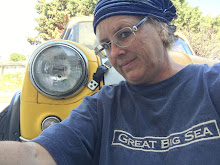
Day seven of moldmaking...
my back hurts
my neck hurts
my arms hurt
my hands are dry and itchy
my Birkies are covered in plaster shavings
I've made a LOT of molds. Here is the tally so far:
2 Kulfi molds
2 Toot Sweet head molds (I owed Addi a head mold, one that I made before was not so good)
1 Toot Sweet body mold
2 Taboo head and tail molds
1 Taboo body mold
2 Dafydd tail molds
1 Dafydd body mold
Partial Brownie body mold
Partial Brownie head mold
Partial Brownie leg mold
One more day and I can stop doing plaster for a while, having gone through 90 pounds of #1 moldmaking plaster. Just finishing the Brownie body, head, and legs and one more Taboo will get me to my goal for this session.
Then, on Friday, I will start with the rubber mold of Little One. I am going to document the process of rubber moldmaking of Little One for a possible article in The Boat, so it will take more time since I will have to pause for photos and writing text each night.It should take about five days, depending upon the weather, since one pour of rubber has to cure for at least 12 hours before doing another one. Then I will go up to Santa Ana and pick up another 100 lb bag of plaster, and do some more plaster production molds. Another Dafydd, an Otto, another Brownie, and maybe two Little One molds should about polish off half of that bag, then we'll see.
In the meantime, here are a couple of little tips for those of you doing plaster molds. Most of which you would know... some of which you might have forgotten... you may have a better method but these work for me.
1. #1 Pottery Plaster has a mix ratio of 100% water to 150% plaster. In other words, you want one and a half times as much plaster as water, by weight. Always put the water in first. Quickly sprinkle/disburse the plaster over the surface of the water... don't dilly dally. Then, let it slack for several minutes.
2. Fresh plaster is smooth, powdery and mixes well. You can feel that it is very soft. If your plaster is grainy, or rough textured, throw it away. You're wasting your time. It won't seal well with the mold soap, and the mold will stick together and possibly risk your original.
3. Apply soap with a soft flat brush, without diluting the soap if you use some variation of PlasterLube. Smells a bit like saddle soap. Apply cleanly, don't flood near the edges, brush it on and don't foam it or agitate it. Wipe with a clean, just slightly damp natural sponge. Reapply like this, twice. Don't apply it to fresh plaster too soon... the plaster needs to set up well. Wait until the plaster has cooled, at least half an hour after pouring it. Otherwise it doesn't seal, and will stick.
4. If you have to do any scraping of the fresh plaster pour, such as removing small blemishes or cleaning up the edge along the model, then take a clean, almost dry sponge and wipe the area that you scraped. This seems to settle the particles down and makes a better seal when you hit it with soap.I didn't used to do this but I swear, it helps.
4. If you sealed the edges of your mold, so that you could remove plaster that might run around the edges and stick to the sides. scrape off the soap when you finish your mold. Sealed edges never evaporate the water from casting as well as unsealed edges. Took me a long time to figure that out. So anything that you can see from the outside when the mold is closed, should not be sealed with soap when you go to use the mold. Just scrape it with a flat metal blade, anything handy. You can tell when the soap has been scraped off.
5. Keep your sponges separate, never dip the soaping sponge (used for large areas, not for the areas nearest the model) into the water. Never dip the water sponge into the mold soap. It dilutes the mold soap, and by the end of the day the soap won't be able to seal anymore. Just as your pour your last pieces, just in time to ruin the whole mold... so watch that mold soap dilution!
6. Rub a finger tip dipped into mold soap onto your mold boards as you begin boxing up your mold. Even with acrylic or well sealed wood, the mold soap will help to release the plaster and keep your boards in good shape. Don't bother to wipe it off... just rub it on like you would grease a muffin pan (obligatory food reference)
Speaking of food... Carlsbad now has a hand dipped chocolate store. Not as good as the one in Boise, but pretty good. A piece of chocolate after a long day of moldmaking does help.
Oh, the photo above? Yasha supervising, of course. On our newly sodded back lawn.


1 comment:
Were I there, I would give you a back massage. And I would not "dilly dally"!!
Post a Comment